Early Pollen Corona
Early Pollen Corona: A Spectacular Natural Phenomenon
Have you ever witnessed a stunning display of colors and brightness surrounding the sun? If so, you may have observed an early pollen corona. This captivating atmospheric optical phenomenon occurs when sunlight interacts with pollen grains suspended in the air. In this article, we will delve into the details of the early pollen corona, exploring its formation, characteristics, and the intriguing science behind it.
The Formation of the Early Pollen Corona
The early pollen corona is created through a process known as diffraction. When sunlight passes through the atmosphere, it encounters pollen grains, which scatter the light in all directions. Each point on the surface of the pollen grain radiates spherical scattered waves, resulting in overlapping and interfering waves. This interference leads to areas of brightness and darkness, ultimately forming a corona.
The Unique Appearance of the Early Pollen Corona
Unlike other coronae caused by spherical water droplets, the early pollen corona exhibits a distinct oval shape with lumpy features. This is due to the non-spherical shape of pollen grains. The irregular surface of these grains results in oval coronae with patches of enhanced brightness scattered throughout.
The Influence of Grain Shape on the Early Pollen Corona
The shape of the pollen grain plays a significant role in determining the appearance of the early pollen corona. For example, alder pollen grains have a flattened bun shape, with roughly pentagonal edges and pores at each edge. The aerodynamic drag acting on these grains causes them to align horizontally, resulting in a horizontally elongated appearance when illuminated by sunlight from a low angle. Consequently, this horizontal elongation translates into vertically elongated coronae.
Verifying the Presence of Alder Pollen
While it may be tempting to attribute the early pollen corona solely to alder pollen, scientific measurements and analysis are necessary to confirm this hypothesis. In the case of the early pollen corona observed in Trier, Germany, the angular dimensions of the corona were calculated from high-quality images captured by Eva Seidenfaden. These dimensions were then compared with predictions based on Mie scattering theory, which describes the interaction of light with small particles.
The comparison revealed that the approximate dimensions of the particles generating the corona were 19 microns in height and 26 microns in width. Remarkably, these measurements align well with the known dimensions of alder pollen grains, as determined by electron microscopy. According to these measurements, alder pollen grains typically measure around 20 microns in height and 23-30 microns in width, providing strong evidence for the presence of alder pollen as the source of the early pollen corona.
Appreciating the Beauty of the Early Pollen Corona
The early pollen corona is truly a sight to behold. Its vibrant rings, characterized by a kaleidoscope of colors and intense brightness, captivate viewers and inspire awe. The phenomenon serves as a reminder of the intricate interactions between light and matter in our atmosphere, showcasing nature's ability to create breathtaking displays.
Conclusion
The early pollen corona is a remarkable atmospheric optics phenomenon that arises from the interaction between sunlight and pollen grains suspended in the air. Its oval shape and lumpy appearance distinguish it from other types of coronae caused by spherical water droplets. By understanding the influence of grain shape and conducting scientific measurements, we can verify the presence of specific pollen types responsible for these captivating displays. So, the next time you gaze at the sun and witness a dazzling array of colors, take a moment to appreciate the beauty of the early pollen corona and the fascinating science behind it.
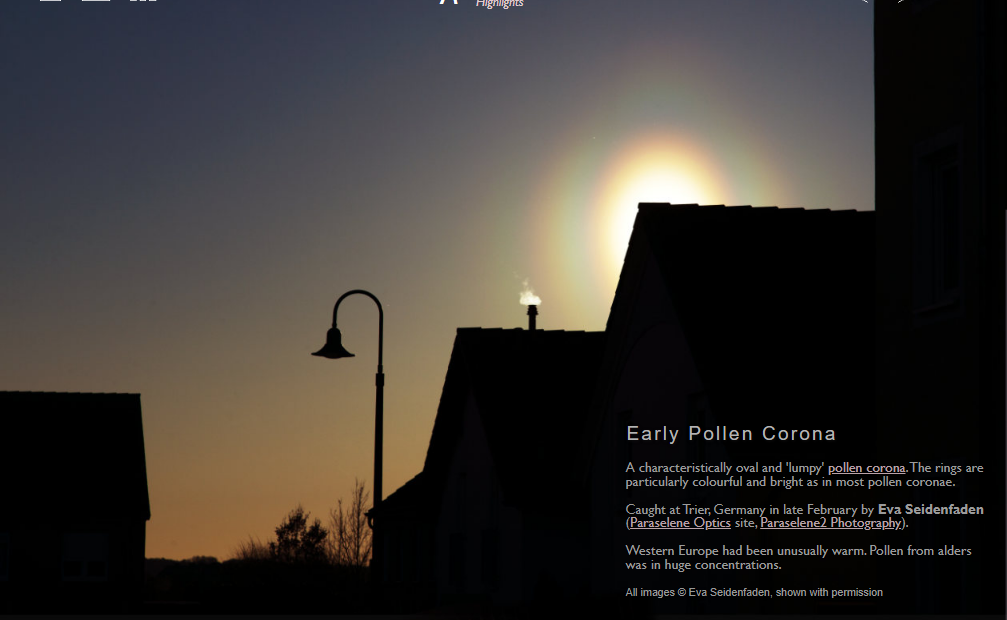
Early Pollen Corona
A characteristically oval and 'lumpy' pollen corona. The rings are particularly colourful and bright as in most pollen coronae.
Caught at Trier, Germany in late February by Eva Seidenfaden (Paraselene Optics site, Paraselene2 Photography).
Western Europe had been unusually warm. Pollen from alders was in huge concentrations.
All images © Eva Seidenfaden, shown with permission
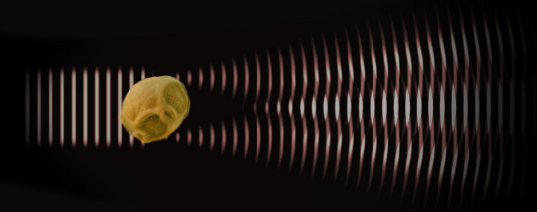
Diffraction The pollen grains scatter sunlight in all directions. We can think of each point on the surface radiating out spherical scattered waves.
The waves overlap and interfere. They produce brightness in some directions and darkness elsewhere. The concentration in the forward direction - seen around the sun - is a corona.
Spherical water drops give smooth circular coronae. Lumpy non spherical pollen grains give oval ones with bright patches here and there.
Drag aligns the grains An alder pollen grain. Alder pollen has a flattened bun shape. The bun edges can be roughly pentagonal with pores at each pentagon edge.
Aerodynamic drag will make it tend to drift with its ring of pores aligned horizontal.. As seen by light from a low sun it will look horizontally elongated.
Horizontal elongated objects give vertically elongated coronae!
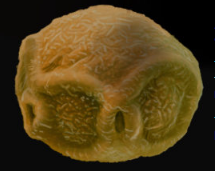
But was it really alder? Arm waving explanations are all very well but do they stand up to measurement? Was alder pollen really responsible?
The corona�s angular dimensions were calculated from Eva�s images and their EXIFs. Then they were compared with Mie scattering predictions. That revealed the approximate dimensions of the particles generating the corona.
They were 19 micron high and 26 micron wide. Alder pollen grains measured by electron microscopy are quoted as 20 micron high and 23-30 micron wide. Not bad agreement!
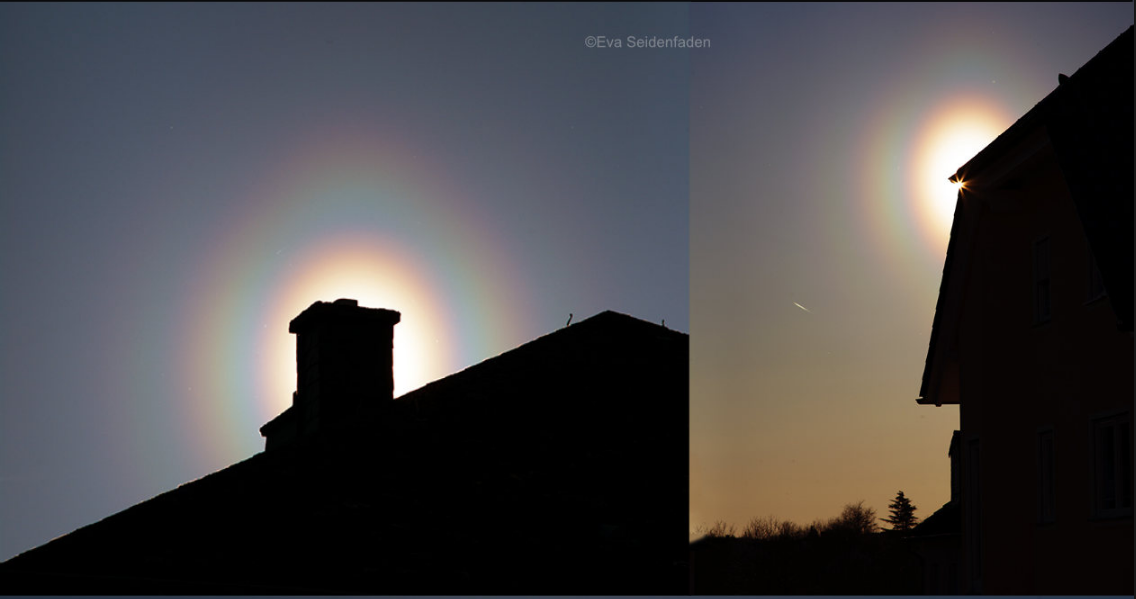
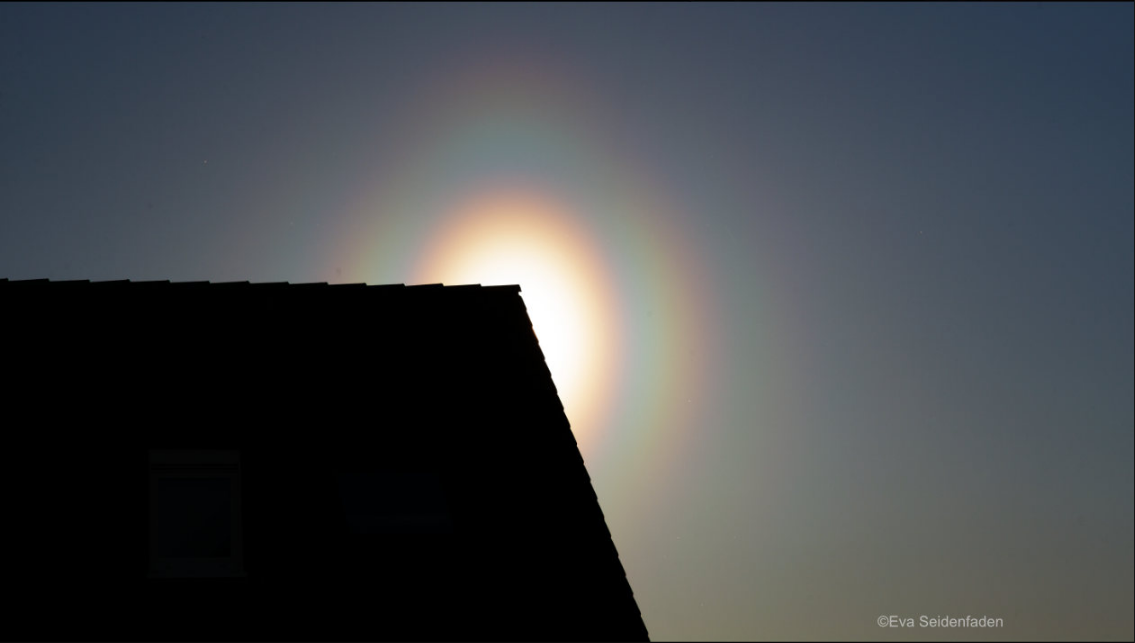
Note: this article has been automatically converted from the old site and may not appear as intended. You can find the original article here.
Reference Atmospheric Optics
If you use any of the definitions, information, or data presented on Atmospheric Optics, please copy the link or reference below to properly credit us as the reference source. Thank you!
-
<a href="https://atoptics.co.uk/blog/early-pollen-corona/">Early Pollen Corona </a>
-
"Early Pollen Corona ". Atmospheric Optics. Accessed on November 25, 2024. https://atoptics.co.uk/blog/early-pollen-corona/.
-
"Early Pollen Corona ". Atmospheric Optics, https://atoptics.co.uk/blog/early-pollen-corona/. Accessed 25 November, 2024
-
Early Pollen Corona . Atmospheric Optics. Retrieved from https://atoptics.co.uk/blog/early-pollen-corona/.